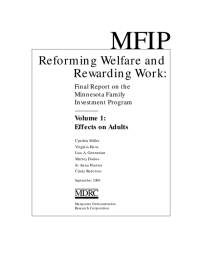Effects on Adults: Final Report on the Minnesota Family Investment Program
In 1994, the state of Minnesota began a major welfare reform initiative aimed at encouraging work, reducing dependence on public assistance, and reducing poverty. The Minnesota Family Investment Program (MFIP) differed from the AFDC system in three key ways:
- Financial incentives to work. Parents could keep more of their benefits when they worked, and child care payments were paid directly to providers.
- Participation requirements for long-term recipients. If not working full time, long-term recipients had to participate in services designed to move them quickly into the workforce.
- Simplification of rules and procedures. Aid to Families with Dependent Children (AFDC), Food Stamps, and Family General Assistance (FGA) were combined into a single program with one set of rules and procedures and one monthly payment.
MFIP began operating in April 1994 in three urban and four rural Minnesota counties, and MDRC, under contract with the Minnesota Department of Human Services, has been tracking the program’s implementation and effects. Between April 1994 and March 1996, over 14,000 families were assigned at random, using a lottery-type process, to either the MFIP or the AFDC system. MFIP’s effects are assessed by following the two groups for up to three years after they entered the evaluation and comparing their employment, earnings, welfare receipt, income, and other measures of well-being. A companion volume of this final report on MFIP presents the program’s effects on additional aspects of families’ well-being and its effects on children.






